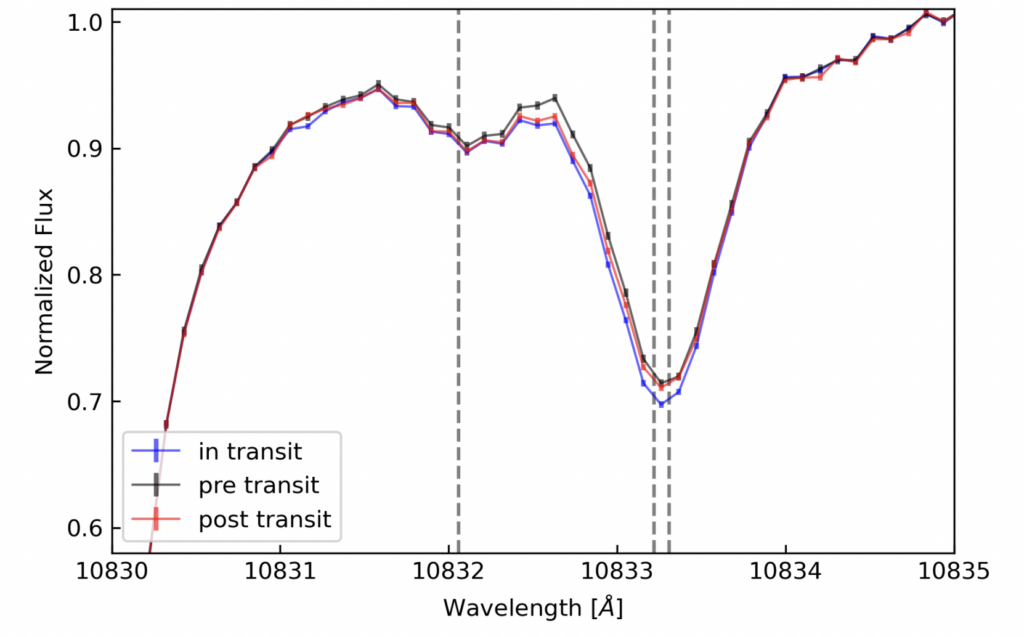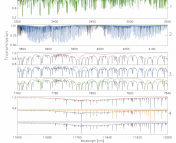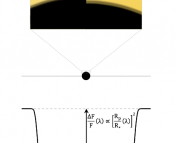Title: WASP-69b’s Escaping Envelope is Confined to a Tail Extending at Least Seven Planet Radii
Authors: Dakotah Tyler, Erik A. Petigura, Antonija Oklopčić, Trevor J. David
First Author’s Institution: Department of Physics and Astronomy, University of California, Los Angeles
Status: Accepted for publication in The Astrophysical Journal (ApJ), available on ArXiv
Outflows in a hot-Neptune desert
Understanding the sizes and orbits of exoplanets is crucial for learning about how planets are born and live out their lives next to their stellar neighbor(s). Over the last few decades, astronomers have found thousands of exoplanets of many varieties, from Earth-like worlds to planets the size of Jupiter but with surface temperatures hot enough to vaporize titanium! Among all the exoplanets we’ve found, there are some types of planets that are rarer than others. It’s estimated that there’s about one planet with a mass somewhere between Earth and Neptune per star. Although these planets are pretty common, there is a notable lack of “hot Neptunes” — these are planets with a radius between 2-8 times that of the Earth (or 0.5-2 times the radius of Neptune) that orbit close to their star (and therefore are really hot!). This lack of hot, Neptune-sized planets is known as the “hot-Neptune desert”.
Why don’t we see many hot Neptunes? One way you could destroy this type of planet is to take a planet the size of Neptune and melt away the outer layers through photoevaporation, the process in which harsh X-ray and UV radiation from a planet’s (nearby) host star ionizes and blows away gas (this is what creates the billowing clouds around stellar nurseries like the Eagle Nebula). If a planet has an evaporating atmosphere made up of hydrogen and helium, this can show up in helium absorption lines, which are produced by UV photons. To gain insight into the impact of host stars on planetary atmospheres, today’s authors take a look at helium absorption on the exoplanet WASP-69b.
Tracking helium absorption over time
WASP-69b is a planet with a radius a bit larger than Jupiter but with about a quarter of its mass. Like many of its exoplanet colleagues, WASP-69b is a planet that we can study through its transit in front of its host star. As WASP-69b passes in front of its host star, some of the light from the star is absorbed or transmitted by the planets and its atmosphere. By observing the spectrum of the host star during a planet’s transit (a technique known as transmission spectroscopy) we can study the composition of the planet’s atmosphere. Its helium absorption — in particular a set of three absorption lines that appear around 10833Å — has been measured in previous studies. In today’s paper, the authors use data from Keck/NIRSPEC, which have better signal to noise than previous observations.

Comparing the helium (He I) absorption triplet at various stages of the transit (Figure 1), the absorption line is deeper while WASP-69b is in-transit and post-transit. The authors also find that the He I is blueshifted both during and after transiting. What does this mean for the atmosphere of WASP-69b? If we see excess helium absorption (this comes from the planet rather than the host star) and the helium absorption feature is blueshifted, then that means that helium from the outer layers of WASP-69b star is being pushed away from the star and toward us observers.
Since we see excess, blueshifted He I absorption during and after the transit of WASP-69b, it appears that the atmosphere of the planet is being stripped away and trails after the planet like the tail of a comet — Figure 2 diagrams this scenario. The authors measure the minimum length of this tail using the length of time when they observe excess He I absorption and the orbital velocity of WASP-69b, and find that the tail is at least 580,000 km long, which is a whopping 7.5 times longer than the radius of the planet! (This is also longer than the previous record-holding tail of WASP-107b.)


To further explore how the He I absorption varies over time, the authors calculate the He I absorption feature’s equivalent width (EW) — which is the width of a spectral line if it were shaped like a rectangle with a height and area equal to the line — before, during, and after the transit. Figure 3 shows that the EW reaches its peak after WASP-69b is in the middle of its transit and is larger in the hours post-transit relative to its pre-transit values. Simulations of evaporating exoplanet atmospheres suggest that this delay in the peak of the EW is the result of stellar winds that shape the outflows of planets in the process of losing material from their outer layer.
Equivalent width is related to the number of helium atoms in the outflow, so it can also be used to make an order-of-magnitude estimate of how much mass WASP-69b is losing from photoevaporation. Using the average equivalent width of the He I absorption feature, the authors find that it loses roughly the mass of the Earth in a billion years. They compare this result with a 1D Parker model to approximate the outflow, and find a mass-loss rate which is nearly the same as their order-of-magnitude calculation.
Why does the tail look longer this time?
How do these new results compare with previous studies of WASP-69b? An analysis using data taken in 2018 with the CARMENES instrument found less excess He I absorption with less blueshift in the post-transit phase and a tail 2.2 times longer than WASP-69b’s radius. Models of the outflow based on these data also predict mass loss rates smaller than what the authors find from the Keck/NIRSpec data.
Why does WASP-69b’s outflow seem more dramatic in the Keck/NIRSpec data? The Keck/NIRSpec has a higher signal to noise ratio, which is especially important in detecting absorption in the post-transit phase when the helium is more diffuse, so this is very likely at least partially responsible for the differences in the post-transit results.
The discrepancy between earlier results and today’s paper may also be a result of changes with the host star over the year between when these data were taken. If the UV emission or stellar winds from the host star varied over this time period, this could impact the He I absorption that traces the length of the tail. Aside from being a useful case study of how exoplanets lose a piece of their atmosphere, more observations of WASP-69b’s outflow could also illuminate how stars can vary over time!
Edited by Jack Lubin
Featured image credit: Gabriel Perez Diaz/IAC




